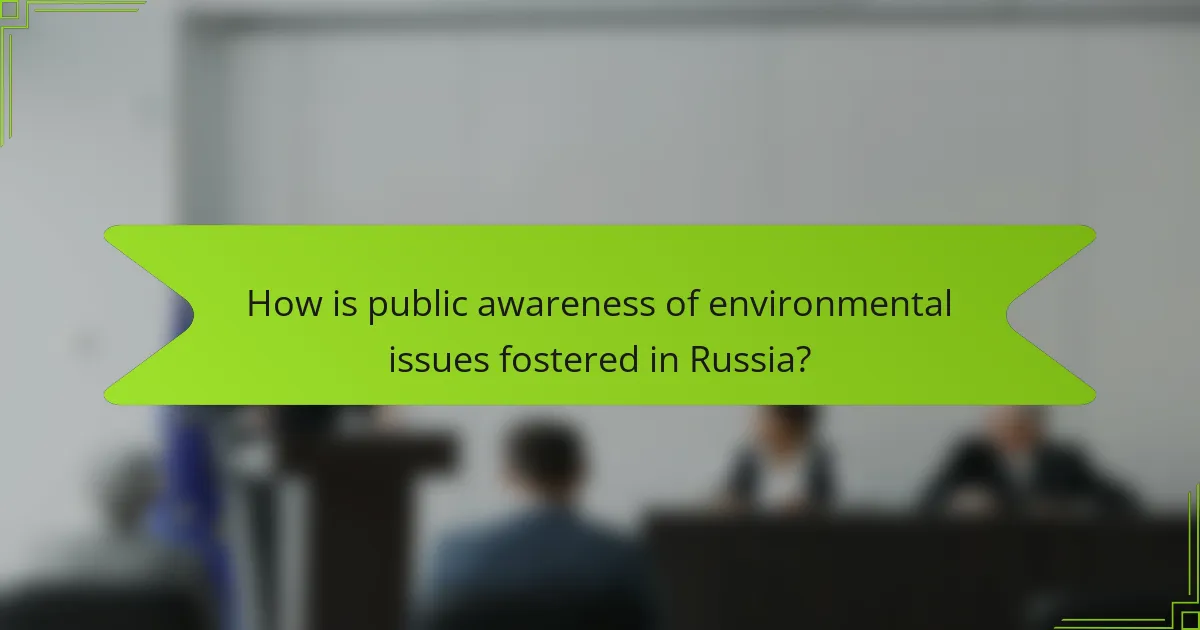The article focuses on Russia’s environmental policies, including the Federal Law on Environmental Protection and the National Environmental Action Plan. These frameworks aim to promote sustainable development, improve air and water quality, and enhance biodiversity conservation. Public awareness initiatives, including government educational programs and non-governmental organization efforts, play a crucial role in increasing knowledge about environmental issues. Additionally, the article examines Russia’s significant contributions to global greenhouse gas emissions and its impact on international climate agreements. Overall, the discussion highlights the interplay between domestic policies, public engagement, and global environmental implications.

What are the key environmental policies in Russia?
Russia’s key environmental policies include the Federal Law on Environmental Protection and the National Environmental Action Plan. The Federal Law establishes the legal framework for environmental protection and resource management. It aims to promote sustainable development and reduce pollution. The National Environmental Action Plan outlines specific goals for improving air and water quality. It also focuses on biodiversity conservation and waste management strategies. Additionally, Russia has commitments under international agreements, such as the Paris Agreement. These policies reflect the country’s efforts to address environmental challenges and promote ecological sustainability.
How do these policies address climate change?
These policies address climate change by implementing measures to reduce greenhouse gas emissions. They promote renewable energy sources and enhance energy efficiency. For example, Russia aims to increase its share of renewables in the energy mix by 4.5% by 2024. Additionally, policies include afforestation and reforestation initiatives to increase carbon sequestration. The government also supports international agreements like the Paris Agreement. This commitment includes setting national targets for emission reductions. Such actions demonstrate a structured approach to mitigate climate impacts.
What specific measures are included in these policies?
Specific measures included in environmental policies in Russia are emissions reduction targets, conservation of biodiversity, and promotion of renewable energy sources. Emissions reduction targets aim to decrease greenhouse gas emissions by specific percentages over set timelines. Conservation initiatives focus on protecting natural habitats and endangered species through designated protected areas. Promotion of renewable energy includes investments in solar, wind, and hydroelectric power to diversify energy sources. Additionally, policies may include regulations on waste management and pollution control. These measures are designed to address climate change and enhance environmental sustainability in Russia.
How do these measures impact local ecosystems?
Environmental policies in Russia significantly impact local ecosystems. These measures aim to protect biodiversity and manage natural resources sustainably. For example, the establishment of protected areas helps conserve habitats and species. Research indicates that protected zones can lead to a 20% increase in local wildlife populations. Additionally, regulations on pollution reduce harmful emissions, improving air and water quality. Studies show that cleaner environments support healthier ecosystems. Furthermore, reforestation initiatives enhance carbon sequestration and restore degraded lands. Overall, these measures foster resilience in local ecosystems, promoting ecological balance and sustainability.
What role does the Russian government play in environmental protection?
The Russian government plays a significant role in environmental protection through legislation and policy implementation. It establishes laws aimed at preserving natural resources and ecosystems. The government is responsible for regulating pollution and waste management practices. It also promotes sustainable development initiatives across various sectors. The Ministry of Natural Resources and Environment oversees environmental policies in Russia. Additionally, Russia participates in international environmental agreements, such as the Paris Agreement. These actions reflect the government’s commitment to addressing environmental challenges. For example, Russia’s Environmental Doctrine outlines strategic priorities for environmental management.
What government agencies are responsible for implementing these policies?
The main government agencies responsible for implementing environmental policies in Russia are the Ministry of Natural Resources and Environment, the Federal Service for Supervision of Natural Resources, and the Ministry of Economic Development. The Ministry of Natural Resources and Environment oversees national environmental policy and legislation. The Federal Service for Supervision of Natural Resources enforces environmental regulations and monitors compliance. The Ministry of Economic Development integrates environmental considerations into economic planning and development strategies. These agencies work collaboratively to address environmental issues and implement policies effectively.
How is funding allocated for environmental initiatives?
Funding for environmental initiatives is allocated through government budgets, grants, and international partnerships. The Russian government designates specific funds for environmental projects in its annual budget. These funds support conservation efforts, pollution control, and sustainable development. Additionally, non-governmental organizations may receive grants for specific initiatives. International partnerships often provide financial support for projects aligned with global environmental goals. The allocation process typically involves assessments of project feasibility and potential impact. Monitoring and evaluation are conducted to ensure effective use of funds. Reports on funding allocation are often published by relevant government agencies.

How is public awareness of environmental issues fostered in Russia?
Public awareness of environmental issues in Russia is fostered through various government initiatives and public campaigns. The Russian government has implemented educational programs aimed at increasing knowledge about environmental protection. These programs often include workshops, seminars, and community events. Non-governmental organizations also play a crucial role in raising awareness. They conduct outreach activities and provide resources to the public. Media coverage of environmental issues has increased, highlighting the importance of sustainability. Social media platforms are used to engage younger audiences effectively. Additionally, international collaborations promote awareness through shared environmental goals. These efforts collectively contribute to a growing public consciousness regarding environmental challenges in Russia.
What educational programs exist to promote environmental awareness?
Educational programs promoting environmental awareness include the Eco-Schools program, Green Schools, and various community workshops. Eco-Schools is an international program that engages students in environmental education through hands-on projects. Green Schools focus on integrating sustainability into the curriculum and school operations. Community workshops often cover topics such as recycling, conservation, and biodiversity. These programs aim to foster a culture of environmental stewardship among participants. Research shows that such initiatives significantly increase knowledge and positive attitudes toward environmental issues.
How effective are these programs in reaching the public?
These programs are moderately effective in reaching the public. Various studies indicate that public engagement varies significantly. For instance, a 2022 survey by the Russian Public Opinion Research Center found that only 40% of citizens were aware of recent environmental initiatives. Additionally, local campaigns showed a higher impact in urban areas compared to rural regions. The effectiveness is often tied to the methods used for outreach. Digital platforms have increased reach, but traditional media still plays a crucial role. Overall, while some segments of the population are informed, a substantial gap remains in comprehensive public awareness.
What role do NGOs play in raising awareness?
NGOs play a crucial role in raising awareness about environmental issues. They educate the public on the importance of sustainability and conservation. NGOs often conduct campaigns to highlight specific environmental challenges. For example, they may focus on pollution, deforestation, or climate change. These organizations utilize various media platforms to disseminate information. They often collaborate with local communities to amplify their message. Research shows that NGOs significantly influence public opinion and policy decisions. According to a study by the World Resources Institute, NGOs have been instrumental in shaping environmental legislation in Russia. Their efforts help mobilize community action and drive governmental accountability.
How does media coverage influence public perception of environmental policies?
Media coverage significantly shapes public perception of environmental policies. It informs citizens about policy developments, impacts, and implications. When media outlets highlight specific environmental issues, they raise awareness and concern among the public. Positive coverage can enhance support for policies. Conversely, negative reporting may lead to skepticism or opposition. Studies show that media framing affects how people interpret environmental challenges. For instance, a 2020 survey indicated that 70% of respondents changed their views on climate change after exposure to relevant news articles. Thus, the media acts as a powerful tool in shaping opinions and behaviors regarding environmental policies.
What are the most common themes in media reporting on environmental issues?
The most common themes in media reporting on environmental issues include climate change, pollution, and biodiversity loss. Media often highlights the impact of climate change on weather patterns and ecosystems. Reports frequently discuss air and water pollution and its effects on public health. Biodiversity loss is another critical theme, focusing on endangered species and habitat destruction. Additionally, media coverage often addresses government policies and initiatives aimed at environmental protection. Public awareness and activism surrounding environmental issues are also prevalent in reporting. These themes reflect growing concerns about sustainability and environmental justice.
How has social media changed the landscape of environmental advocacy?
Social media has significantly transformed environmental advocacy by enhancing communication and mobilization. It allows activists to reach wider audiences quickly. Platforms like Twitter and Instagram facilitate real-time sharing of information. This immediacy helps raise awareness about urgent environmental issues. For example, movements like #FridaysForFuture gained global traction through social media. Studies show that social media campaigns can increase public engagement in environmental issues. Additionally, social media enables grassroots organizations to connect with supporters easily. This connectivity fosters collaboration across different regions and demographics. Overall, social media has democratized environmental advocacy, making it more accessible and impactful.

What is the global impact of Russia’s environmental policies?
Russia’s environmental policies significantly influence global environmental efforts. The country is a major player in greenhouse gas emissions, contributing about 5% of the world’s total emissions. Its reliance on fossil fuels hampers international climate agreements. Russia’s policies often prioritize economic growth over environmental protection. This approach can lead to deforestation and biodiversity loss. Furthermore, Russia’s Arctic policies impact global climate change due to melting permafrost. The country’s stance on international environmental cooperation affects global initiatives. For instance, Russia’s withdrawal from certain agreements can weaken collective climate action. Overall, Russia’s environmental policies have far-reaching implications for global sustainability efforts.
How do Russia’s policies align with international environmental agreements?
Russia’s policies partially align with international environmental agreements. The country is a signatory to several key agreements, such as the Paris Agreement. However, implementation of these commitments often faces challenges. Russia has set greenhouse gas reduction targets but has been criticized for insufficient action. The country prioritizes economic growth, which can conflict with environmental goals. Additionally, domestic policies sometimes lack enforcement mechanisms. Reports indicate that Russia’s reliance on fossil fuels complicates its compliance with international standards. Overall, while there is a framework for alignment, significant gaps remain in practical application.
What commitments has Russia made to global climate goals?
Russia has committed to reducing its greenhouse gas emissions by 30% from 1990 levels by 2030. This commitment aligns with the Paris Agreement, which aims to limit global warming. In 2020, Russia submitted its updated Nationally Determined Contribution (NDC) to the United Nations Framework Convention on Climate Change. The NDC outlines Russia’s intentions to transition towards a low-carbon economy. Additionally, Russia aims to achieve carbon neutrality by 2060. The government has initiated various projects to promote renewable energy sources and improve energy efficiency. These commitments reflect Russia’s acknowledgment of the importance of addressing climate change on a global scale.
How is Russia’s approach perceived by other nations?
Russia’s approach to environmental policies is often perceived as insufficient by other nations. Critics highlight the country’s reliance on fossil fuels and slow progress in adopting renewable energy. Many nations express concern over Russia’s lack of commitment to international climate agreements. For instance, Russia’s emissions targets under the Paris Agreement are viewed as inadequate. Additionally, environmental organizations frequently point to environmental degradation in Russia as a significant issue. The perception is that Russia prioritizes economic growth over environmental sustainability. This stance has resulted in strained relationships with countries advocating for stronger climate action. Overall, Russia’s environmental policies are seen as lagging behind global standards.
What challenges does Russia face in implementing effective environmental policies?
Russia faces significant challenges in implementing effective environmental policies. These challenges include economic dependency on fossil fuels, which discourages investment in sustainable practices. Corruption within governmental institutions hampers policy enforcement and accountability. Additionally, lack of public awareness and engagement limits citizen support for environmental initiatives. The vast geography of Russia complicates monitoring and managing environmental degradation across diverse ecosystems. Furthermore, outdated infrastructure and technology hinder the adoption of modern, eco-friendly practices. International sanctions have also restricted access to advanced environmental technologies and funding. Lastly, political prioritization of short-term economic growth often overshadows long-term environmental goals.
How do economic factors influence policy effectiveness?
Economic factors significantly influence policy effectiveness by determining resource allocation and public support. A strong economy can lead to increased government revenue, enabling better funding for environmental initiatives. Conversely, economic downturns often result in budget cuts, impacting the implementation of such policies. For example, during the 2008 financial crisis, many countries scaled back environmental programs due to reduced public spending. Additionally, public perception of economic stability affects voter support for environmental policies. When citizens prioritize economic growth, they may oppose stringent regulations that they perceive as harmful to business. Thus, the interplay between economic conditions and policy support is crucial for the success of environmental initiatives.
What are the major political barriers to environmental reform?
Major political barriers to environmental reform include vested interests, lack of political will, and bureaucratic inertia. Vested interests often prioritize short-term economic gains over long-term environmental sustainability. Political leaders may lack the will to implement necessary changes due to fear of losing support from influential industries. Bureaucratic inertia slows down the decision-making process, making it difficult to enact new policies. Additionally, corruption can undermine effective environmental governance. These barriers are evident in various instances, such as the slow progress of Russia’s environmental legislation despite international commitments.
What can individuals do to support environmental initiatives in Russia?
Individuals can support environmental initiatives in Russia by participating in local clean-up events. These events help remove litter from parks and waterways. Additionally, individuals can reduce waste by recycling and composting at home. Supporting local environmental organizations through donations or volunteering is also beneficial. Advocating for sustainable practices within their communities raises awareness. Individuals can also reduce their carbon footprint by using public transport or cycling. Educating themselves and others about environmental issues promotes a culture of sustainability. Engaging in tree planting initiatives contributes to reforestation efforts. These actions collectively enhance environmental protection in Russia.
What practical steps can citizens take to reduce their environmental impact?
Citizens can reduce their environmental impact by adopting sustainable practices. They can start by reducing waste through recycling and composting. Using public transport, carpooling, or biking minimizes carbon emissions. Conserving energy at home by using energy-efficient appliances is also effective. People can save water by fixing leaks and using water-saving fixtures. Supporting local and sustainable products reduces the carbon footprint associated with transportation. Engaging in community clean-up events helps maintain local ecosystems. Educating others about environmental issues fosters a culture of sustainability. Each of these actions contributes to a collective effort in mitigating environmental impact.
How can individuals get involved in local environmental advocacy efforts?
Individuals can get involved in local environmental advocacy efforts by participating in community clean-up events. Many organizations host regular clean-ups to address litter and pollution. Joining local environmental groups can also provide opportunities for advocacy and education. Attending town hall meetings allows individuals to voice concerns and influence local policies. Volunteering for environmental campaigns helps raise awareness about critical issues. Engaging with social media platforms can amplify environmental messages and mobilize support. Supporting local conservation projects directly contributes to environmental preservation. Lastly, signing petitions can influence decision-makers on environmental legislation. These actions collectively strengthen community efforts toward sustainability and environmental protection.
Environmental Policies in Russia encompass key initiatives such as the Federal Law on Environmental Protection and the National Environmental Action Plan, which aim to promote sustainable development, reduce pollution, and address climate change. These policies include specific measures for emissions reduction, biodiversity conservation, and the promotion of renewable energy sources, significantly impacting local ecosystems and public awareness. The Russian government, through various agencies, plays a crucial role in implementing these policies while facing challenges related to economic dependency on fossil fuels and public engagement. Additionally, Russia’s environmental commitments are scrutinized on the global stage, influencing international climate goals and perceptions of its environmental governance.